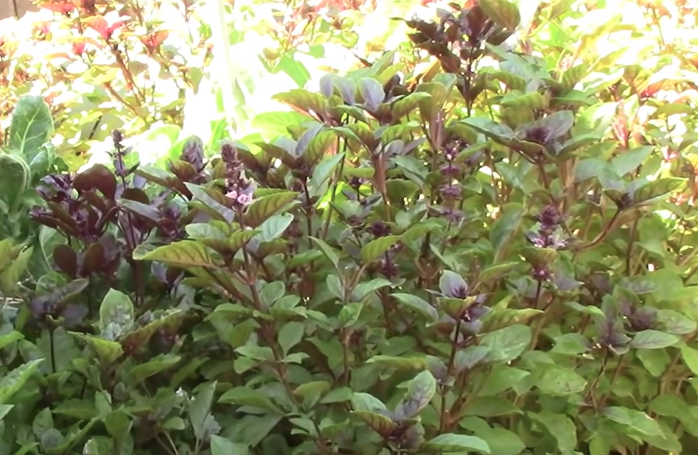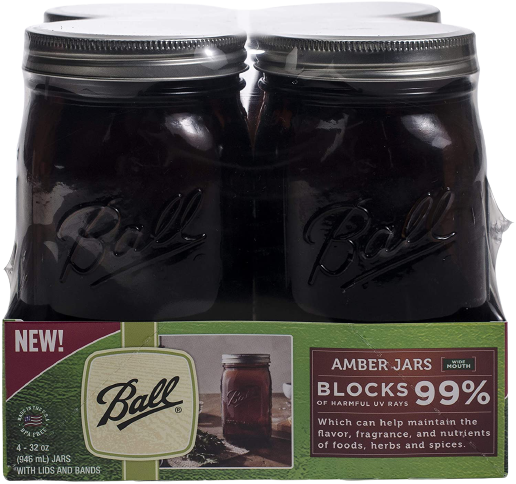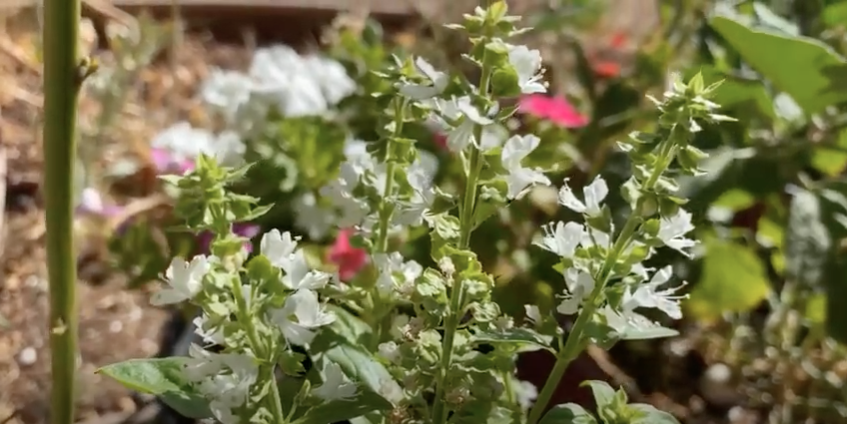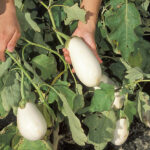Basil flowers are nutritious edible organs of the basil plant that are produced in abundance by the herb in summer. Basil bloom which is purple or white in color, depending on the basil variety under cultivation, has a functional purpose attributed to antonycinns. The flowers serve culinary, medicinal, and ornamental purposes. The majority of basil growers unwittingly limit recipe application of the herb to its leaves although the flowers are also good to eat. In this feature, we discuss the basil flowers and explain the various culinary and non-culinary uses of basil flowers.
Table of Contents
What are Basil Flowers
Basil flowers are a colorful human edible organ of the basil plant. The flowers are regular plant flowers produced by the basil plant which itself is a member of the species Ocimum basilicum of the Mint family. Common family members of Mint which are often used in a wide range of food recipes include thyme, rosemary, mint and sage. Basil florets taste and smell, for the most part, like the basil leaves themselves although they may be milder. If you can use basil leaves in Mexican dishes, there should be room to also use the flowers!
Basil flowers can be white or purple in color depending on the basil cultivar growing. In the garden, the flowers are extremely useful for pollination and are a favourite among pollinating insects. As such, flowering basil has been shown to enhance pollination of bell peppers.
Green basil varieties, such as Italiano Classico, produce white flowers while purple basil varieties correspondingly produce purple florets. Examples of purple flower producing basil varieties are Red Rubin and Dark Opal. By virtue of their purple/dark pigment, these varieties are rich in health beneficial anthocyanins.
Basil herb flowering process begins with budding and is followed by the actual bloom. The flower organ is edible at both these stages. Basil flowering is a spectacular scene of ornamental value in most gardens. However, according to the University of Illinois Extension, when let to flower, basil leaves themselves will produce less flavor and aroma. This is one of the reasons many home growers are committed to and encourage nipping basil flowers at first appearance.
Growing conditions and other environmental conditions influence how fast basil plants start bolting. Bolting is another way of talking about budding and flowering of the basil herb. Basil plants grown in pots will produce flowers quicker than those planted in the ground. Summer heat is a well appreciated trigger of flowering in basil plants.
If left to go all the way, basil flowers will eventually produce potent seed following a drying process on or off the plant. This seed produced is also edible. Even so, according to 2021 research findings which appeared in the journal Foods, basil seeds are a potential source of nutrients and functional ingredients with beneficial health properties. There still remains room for culinary interest in basil organs to go beyond just basil flowers but also basil seeds themselves.
Purple Basil Flowers

As earlier stated, basil bloom can be white or purple. Purple basil flowers can be used in the same manner as white flowers i.e. in food and beverages (see recipes section). More importantly, purple basil flowers have a special health advantage over regular white basil flowers although both are desirable. In particular, purple flowers produced by basil cultivars such as Red Rubin and Dark Opal are rich in anthocyanins. Anthocyanins also occur in other vegetables such as purple broccoli and purple lettuce.
A riveting study was carried out into purple basils whose results were published in 1998. According to the Journal of Agricultural and Food Chemistry, purple basils contain as many as 14 different anthocyanins. Anthocyanins are compounds with antioxidant effects. Antioxidants help human cells protect and repair the harmful actions of free radicals which are responsible for human cell damage which, in turn, has been linked to diseases such as cancer.
Purple basils were found to have the highest concentration of total anthocyanins just before they begin flowering. Admittedly, this particular study focused on the purple basil plant itself and not the purple basil flowers per se. However, it gave useful insights into the overall promise of purple basil, the source of the purple flowers in the first place.
Nonetheless, a different study published in 2019 in the journal Plants established that purple basil flowers contain higher antioxidant capacity than the leaves themselves, which have a higher level of anthocyanins. Even more interesting was that white basil flowers had a remarkably higher antioxidant capacity in comparison to purple basil flowers although white flowers have much lower anthocyanin content.
Overall, these findings seem to suggest that consuming white basil flowers may have some notable advantage over purple basil flowers in as far as antioxidants are concerned. However, purple flowers have a higher level of anthocyanins in general due to their deep pigmentation. In the end, both types of flowers are good to consume.
This is to say, basil flowers remain beneficial edible parts of the basil herb. Perhaps the focus should be on how to consume basil blossoms, which is our interest in the next section.
What to do with Basil Flowers
There are things to do with basil flowers chief of which is culinary or recipe related. Some gardeners use basil flowers in tea, some go as far as dipping the flowers in batter, deep frying them and serving as a side dish with peppers and greens. Basil flowers can also be blended with white cider vinegar, with watermelon or with coconut milk to create exotic yet nutritious juices. The watermelon, in particular, can be used in blended juices to effectively mask the licorice flavor produced by Thai Basil, for example.
Although most home gardeners nip basil flowers off the plant to encourage more basil leaf production, as already shown through earlier cited studies, there is a great opportunity to use basil florets in recipe preparations for nutritional and functional benefits.
It is apparent that basil flowers teeter on the side of functional foods. In this regard, the Academy of Nutrition and Dietetics, frames functional foods as those foods which go beyond the traditional sense of nutrition to provide some level of superior health benefit. The superior health benefits associated with functional foods include anti-cancer, anti-inflammatory properties, for example.
The following are some suggested basil flower recipes.
Basil Flower Recipes
| Basil Flower Vinegar Recipe – this recipe produces a vinegar with a difference using 8 basil flower heads. The flowers are harvested, washed and carefully patted dry before being placed in a container and white vinegar is added. The mixture is left to sit for several days. Thereafter a few more steps are followed before the vinegar is ready for use. View Recipe. |
| Raspberry Basil Blossom Gin Smash Recipe – this is yet another beverage recipe making use of often thrown away basil flowers. The recipe ropes-in ripe raspberry flavor and the fragrance of purple basil florets. Other recipe ingredients are gin, lemon and syrup. View Recipe. |
| Three-Herb Iced Tea Recipe – this is a non-alcoholic beverage recipe that takes only 10 minutes to make. Ingredients in the recipe are fresh mint, basil and a simple syrup infused with chamomile flowers. Replace basil leaves with basil flowers as these have nearly the same taste and flavour. View Recipe. |
| Herb Flower Pesto Recipe – this recipe produces a scrumptious paste made of cocktail herb flowers one of which is basil florets. The pesto can be used on pasta or as topping for fish. It can also be used to marinade meats such as chicken, pork chops and beef. All in all, the recipe calls for 3.5 cup flowers of basil, sage, and rosemary. View Recipe. |
| Basil Flower Pesto Recipe – this is yet another pesto recipe. However, this recipe uses only basil flowers and not a cocktail of other herbs as is the case in the foregoing one. Ingredients for this recipe will be some off-the-stem basil flowers, Parmesan cheese, pine nuts and some extra virgin oil among other items. All the ingredients are ultimately put in a food processor to produce the final product. View Recipe. |
| Basil Blossom Infused Olive Oil – this simple recipe takes existing plain olive oil and infuses it with the aromatic basil blossom flavor. The lengthy basil florets are first cut to shorten them and then put into a bottle. Olive oil is added to the bottle covering all the flowers in the bottle. The bottle is left to sit for an extended time before the infused olive oil is ready to use. View Recipe (Video). |
Fresh Basil Flower Tea Recipe
One of the most common and easy applications of basil florals is making some basil blossom tea. This recipe produces two servings of basil flower tea. The number of servings can easily be increased by doubling the ingredients. Furthermore, the lemon and honey or sweetener in this recipe are optional.
Directions
- Pick some fresh basil florets with leaves from your flowering basil plant
- Carefully wash the picked florets under running water
- Boil the 2 cups of water in a pot
- Take a cup and add the picked basil flowers
- Add the hot water to the cup
- Cover and let the cup sit for some 10 minutes
- Strain and transfer the mixture to another cup and discard the strained basil flowers
- Add honey or sweetener to the basil tea and serve hot or warm.
Saving Basil Seed from Flowers
Apart from food related uses of basil flowers, seed can also be saved from bolted basil plants. This is one way to ensure ready seeds for use in the following year. Basil makes so much seed you never have to buy basil seed again. If you are new to saving seed, we recommend this guide by Seed Savers Exchange (SSE) on saving seed for beginners.
The following are our suggested steps for saving basil seed when the herb flowers.
Basil seed saving steps
- Get a medium size container or tub
- Collect dry flowers from the plant into the container
- Begin crushing the flowers with hands for the petals to release the seeds
- After thoroughly crushing the dry basil flowers, take a sieve and sieve the crushed material through
- Collect the tiny seeds as they drop through the sieve or remain in the sieve
- Separate the tiny seeds from any unwanted material that went through the sieve
- Pack, label (including date) and store the seeds for next season planting
How to Dry Basil Flowers
Considering that basil plants continuously produce flowers, it is not at all possible to put all the fresh basil flowers to use at once and stay on top of things. One effective method of storing basil blossoms for the longer term is by drying them. The dried blossoms can later be used in recipes or saved for seed.
The following steps show how to dry basil flowers easily.
basil seed drying steps
- Clip all the basil flowers appearing on the plant, at the stem.
- Bunch up the flowers in clusters of 5 or 6 and tie them together with a string at the stem end.
- Hang the flowers upside down in a dry and warm location for 5 to 6 days
- At the end of the hanging period, check if the flowers are sufficiently dry.
- Store in an air-tight, light free jar (see below) for later crushing to use as seasoning in recipes.
 |
| Amber Storage Jars – Most commercial herbs are sold crushed and this is what most people are used to. However, when growing your own herbs, there is an opportunity to make the best out of the herbs through better preparation and storage. This is good for longer term flavor and aroma. Only herbs that are needed are crushed in batches at a time. Instead of storing your dried basil flowers in zip-lock bags and other such containers, we suggest these air-tight amber jars that block out light. Light works against the quality of your herbs. These jars help your basil flowers maintain their flavor, fragrance and nutrients on a longer term basis. See on Amazon. |
Conclusion
Basil flowers are edible parts of the basil herb. They provide some nutrition and superior health benefits. Basil blossoms can be white or purple, both of which are edible and used in a variety of food and beverage preparations. Basil flowers have been scientifically shown to contain compounds that are beneficial to human health. For this reason, the flowers and the leaves of the herb have similarities with benefits offered by known functional foods. Apart from food, basil florets, when dried, can be used to save seed for planting during the following season.
Random But Good Reads:

